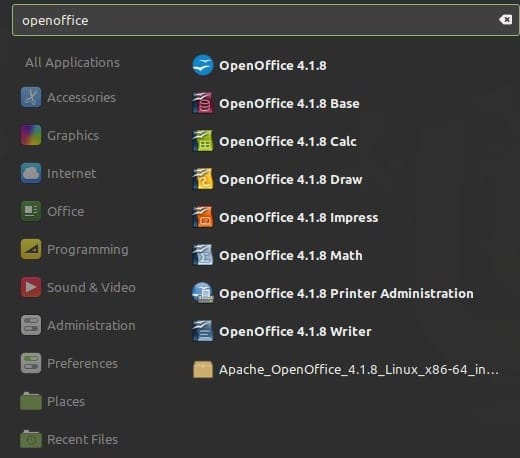
- #APACHE OPENOFFICE SPREADSHEET TUTORIAL DOWNLOAD APACHE OPENOFFICE#
- #APACHE OPENOFFICE SPREADSHEET TUTORIAL FULL ANSWER GETS#
Apache Openoffice Spreadsheet Tutorial Download Apache OpenOffice
To set up the Calc spreadsheet Download Apache OpenOffice for Windows now from Softonic: 100 safe and. The solutions described here are compatible with LibreOffice 5, OpenOffice 4.0 and Star Office 8. This tutorial describes how to use IDAutomations barcode fonts in Apache OpenOffice and LibreOffice by The Document Foundation. LibreOffice & OpenOffice Tutorial.
SUMPRODUCT's origin is from mathematics where one often calculates the sum of sets of products. This tutorial explores some of those situations. This tutorial covers the steps to creating a basic spreadsheet in Open Office Calc.Tutorial Downloading Apache OpenOffice (sourceforge.net) by floris v Sun 11:14 pm 0 Replies 3525 Views Last post by floris v Sun 11:14 pm Tip Using spreadsheet functions in Basic by WolfVanZandt Fri 3:15 am 1 Replies 5205 Views Last post by Villeroy Fri 1:37 pmThe SUMPRODUCT function has many uses in Calc. The program is easy to use and contains most, if not all of the commonly used features found in spreadsheets such as Microsoft Excel. Ask them in the Applications → Calc section.Open Office Calc is an electronic spreadsheet program offered free of charge by openoffice.org.
For the data below, the formula would be =SUMPRODUCT(A2:A4 B2:B4). We summed the three sets of products. For example, if we buy five kilos of apples at $4/kilo, two kilos of bananas at $1/kilo, and three kilos of cherries at $10/kilo, the total cost is (5×4)+(2×1)+(3×10) = 52 dollars.
It first performs the three products A2*B2, A3*B3, and A4*B4, then produces the summed result A2*B2 + A3*B3 + A4*B4. SUMPRODUCT multiplies the corresponding cells in the ranges, then adds them to produce a single number. The second range B2:B4 has the prices. The first range A2:A4 has the weights purchased.
SUMPRODUCT can also perform counting and summation involving empty cells. Hilary Stoupa Hi - I am trying to follow this tutorial on connecting PowerApps to the Office 365 user profile data.In Calc, an important use of SUMPRODUCT is to perform conditional counting or summation, as one can do with COUNTIF, SUMIF, COUNTIFS, and SUMIFS. In the video below, Here I explain create the table using formula Weekday, Workday, and Networkdays formulas.Apache OpenOffice Community Forums. It can be downloaded and used completely free for any purpose.
How does that work? Before SUMPRODUCT can perform the multiplications it must evaluate the expression in the second operand, which asks it to compare four cells in column A with the constant "WI". We will get total sales for Wisconsin (WI) in the data below using =SUMPRODUCT(B2:B5 A2:A5="WI"). Let's take a look at an example so you can wee why these values are important. We can use SUMPRODUCT for counting and summation because the logical functions, some of the information functions, and the relational operators =, , and >= produce TRUE or FALSE, where TRUE has the value 1 and FALSE has the value 0.

Note that all four operands have three rows and two columns. For example, =SUMPRODUCT(A2:B4 E2:F4 I2:J4 M2:N4) will multiply the corresponding entries the four ranges, then add them. We can use any reasonable number of operands, as long as the specified ranges have the same size.
It's easier to understand this calculation if we display the values of the four operands in a table, below. Our formula is =SUMPRODUCT(B2:B7 A2:A7="WI" C2:C7=2017 B2:B7>400).As before, Calc must evaluate the operands before the multiplications can proceed. Building on the last example let's calculate the total of sales which were more than $400 for Wisconsin in 2017 using the data below. Specifically, SUMPRODUCT calculates A2*E2*I2*M2 + A3*E3*I3*M3 + A4*E4*I4*M4 + B2*F2*J2*N2 + B3*F3*J3*N3 + B4*F4*J4*N4.You may wonder why anyone would want to use four operands.
We sometimes use one operand when the goal is to count the numbers of cells which satisfy a single condition. In that case there is nothing to multiply the results are just added. This is the total for the sales which meet all the criteria.A special case is when SUMPRODUCT has one operand. The total of all the products is 0+0+0+750+0+440 or 1190. The fourth and sixth rows contain a sales number and three ones so those products are those two sales, 750 and 440. The first, second, third and fifth rows contain a zero so the product is zero.
Apache Openoffice Spreadsheet Tutorial Full Answer Gets
A simplified explanation is: SUMPRODUCT understands what to do with an operand like ISEVEN(A2:A5) but SUM does not. The full answer gets complicated and somewhat beyond the scope of this tutorial. Note that you cannot perform this count using COUNTIF without using an auxiliary column to hold the ISEVEN function.In the last example, why we don't use SUM instead of SUMPRODUCT since no multiplications are being performed. SUMPRODUCT adds 0+0+1+1 for the result 2. ISEVEN is a function which returns 1 (TRUE) for even numbers and 0 (FALSE) for odd numbers. The formula is =SUMPRODUCT(ISEVEN(A2:A5)).
You're not expected to study them in detail they're for reference. The remainder of the tutorial will list many situations where SUMPRODUCT can be used. But the important thing to know is that SUMPRODUCT is the correct function to use for conditional counting and summation.You are encouraged to copy the sample formulas below to a spreadsheet and experiment with SUMPRODUCT, learning by doing. There are good, but perhaps confusing, reasons for that and, yes, the answer is correct and, yes, there are ways to force SUM to work for this situation.
You'll see "criteria" used several places below. Examples here show data arranged in columns of cells, but SUMPRODUCT also works with data in rows of cells. Row 1 is excluded because it is typically a column name.


 0 kommentar(er)
0 kommentar(er)
